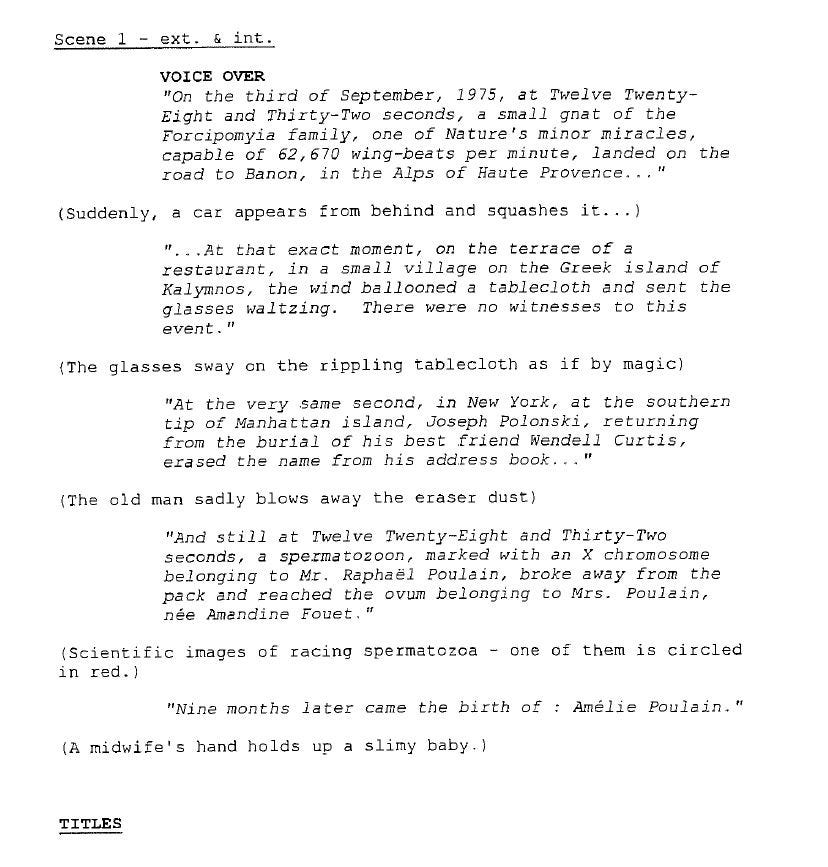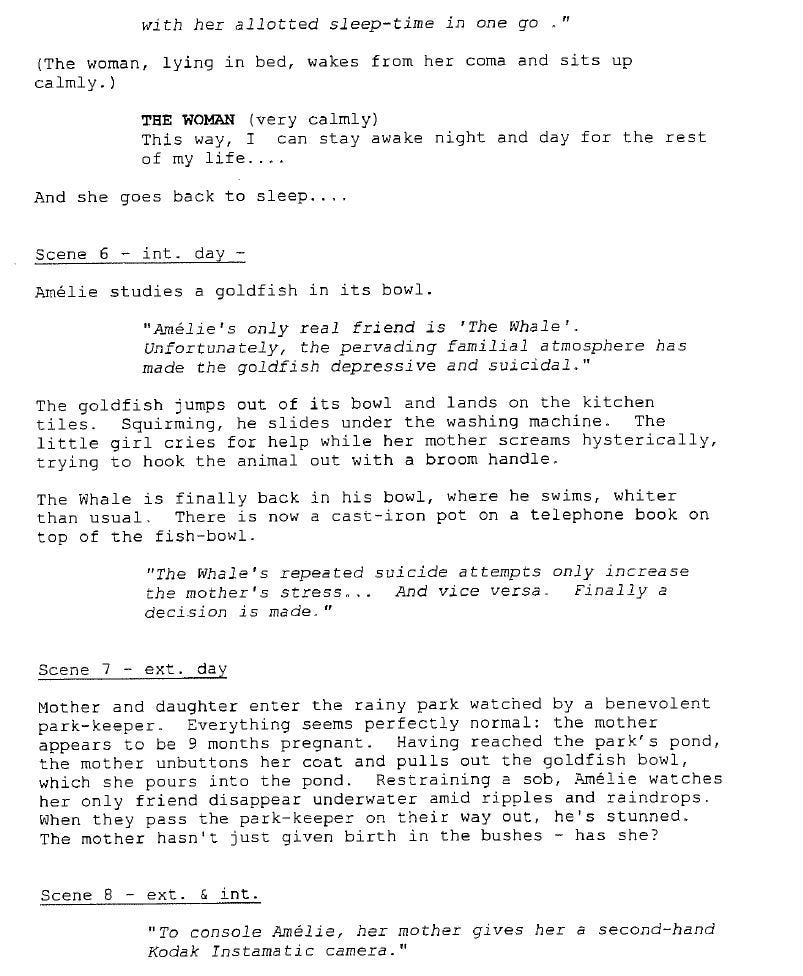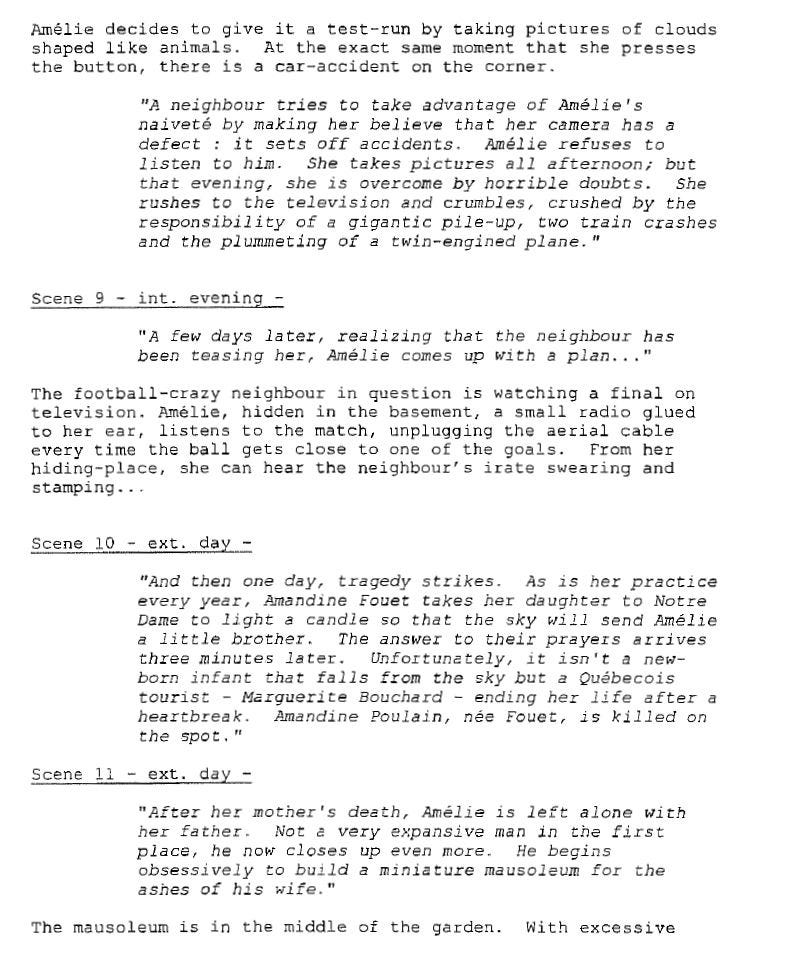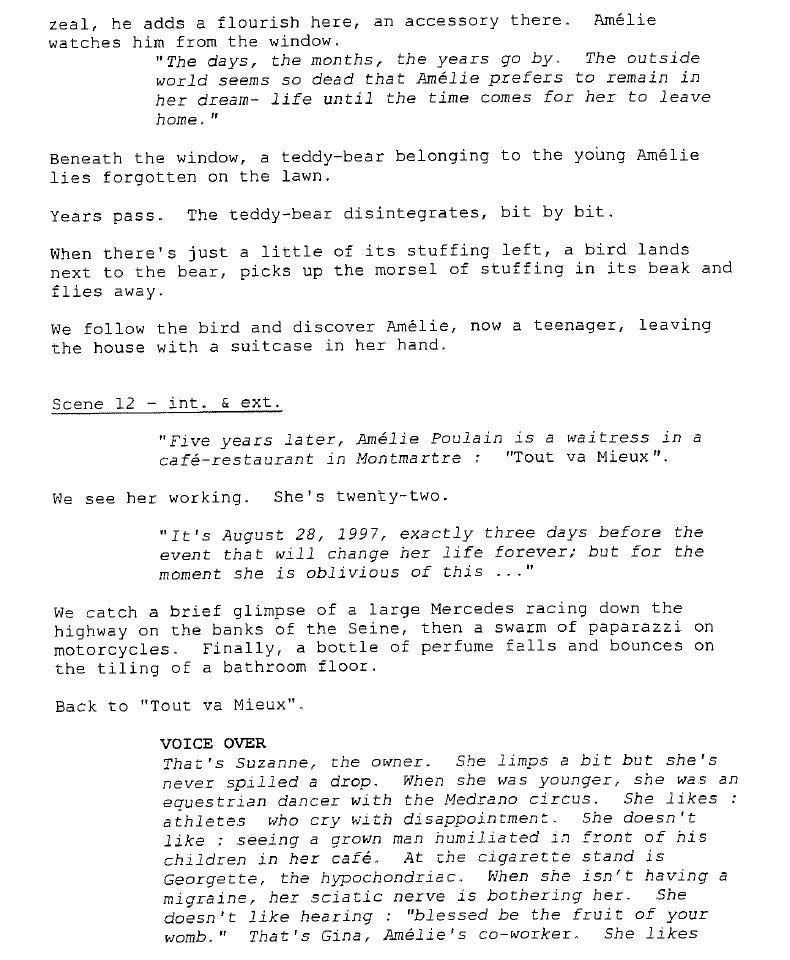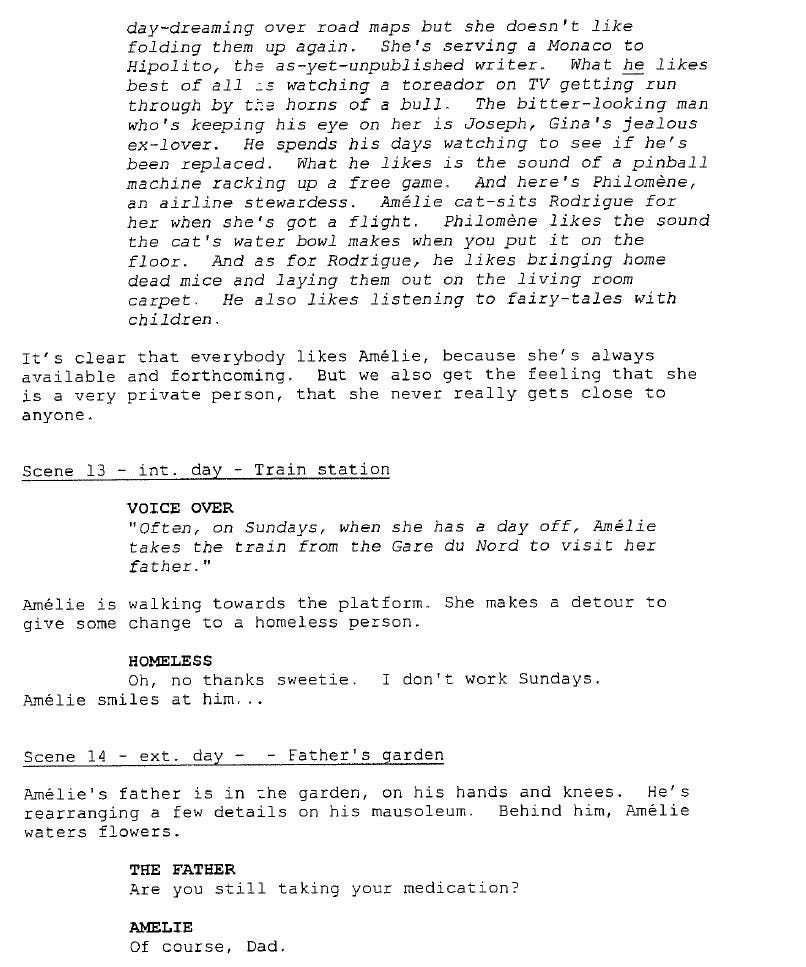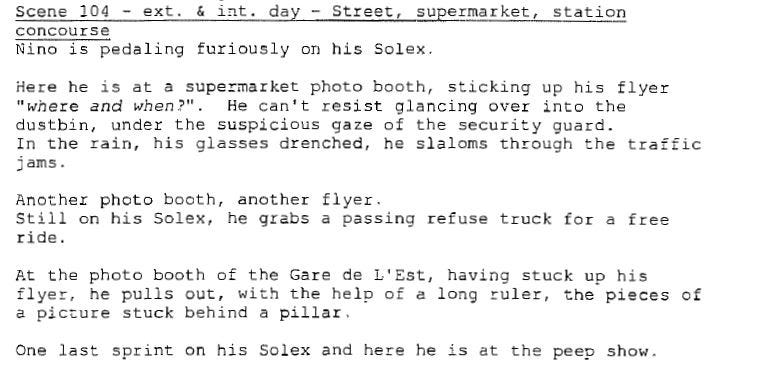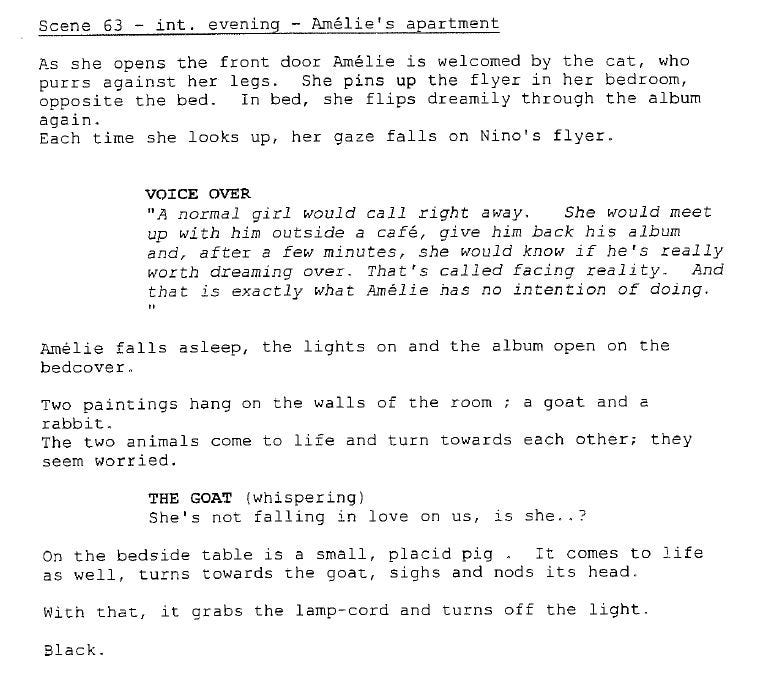Amélie (2001) Script Review | #43 WGA 101 Greatest Scripts of the 21st Century
A whimsical and cheerful comedy that finds the sweet spot between sincere and saccharine.
Logline: At a tiny Parisian café, the adorable yet painfully shy Amélie accidentally discovers a gift for helping others. Soon, Amélie is spending her days as a matchmaker, guardian angel, and all-round do-gooder. But when she bumps into a handsome stranger, will she find the courage to become the star of her own love story?
Written by: Guillame Laurent & Jean-Pierre Jeunet
Pages: 102
Scenes: 128
There’s whimsy, and then there’s Amélie.
Even on the page, its heightened sensibilities are apparent, turning the quirky story about a shy young waitress into something almost fantastical. A fairy tale, even. It skirts the edges but never falls into sentimental territory. It’s too sincere to make that mistake.
The premise is simple. Amélie, the only child of a distant father and neurotic mother, grew up in a cloistered life without friends. To cope, she retreats into her world of fantasy, finding pleasures in small things, like dipping her hand into a sack of rice. One day, she discovers an old tin box hidden behind a loose tile in her apartment. The box contains childhood mementos that belonged to the apartment’s previous occupant, Bretodeau. Intrigued, she successfully tracks him down and returns the box, and the anonymous gesture overwhelms Bretodeau, prompting him to reconnect with his adult child. The outcome inspires young Amélie to help other people in her life, often with amusing results.
Some writers might have used the event of the box and Bretodeau as the main event of the script. Here, it only serves as a launch pad for sending Amélie on her new quest. She fakes a lost letter to help her landlady move on from the death of her cheating husband; she motivates the timid grocer, Lucien, to become confident by messing with his overbearing boss’s apartment (adding salt to his liquor, changing the lights, doorknobs, and telephone numbers to make him think he’s losing his mind); she convinces her father to fulfil a dream of seeing the world by stealing the garden gnome and sending pictures of it posing in various parts of the world. Amélie also befriends her reclusive neighbor, the painter Dufayel, who suffers from brittle bones. But the question is: Will Amélie help herself when she is drawn to the handsome young Nino? Or will she scuttle back to her hidey-hole?
The screenplay has an almost episodic structure that could make it easily transferrable as a limited series on television. It contains 128 scenes within its 102 pages, and it is written differently from standard American or British screenplays. For starters, this is a translated screenplay. For another, it does not follow the usual formatting style. Note how in the opening eight pages, the voice-over is written and dominates the page with the visuals inserted in parentheses.
Also note how the writers efficiently and effectively pack reams of information in a clever, concise manner. There are a lot of visuals but the voice over is so descriptive that sometimes, there’s no need to describe it. Take Scene 10 in which Mrs. Poulain is killed by a suicidal tourist on page 6; the voice over tells us everything we need to picture the scene instead of spelling it out entirely.
In another example, Scene 104 on page 80, the slugline contains all the locations connected to it instead of breaking it down, setting up all the events in a few paragraphs to maintain the momentum.
Although this practice might be frowned upon in Hollywood (read: thrown out and vehemently rejected as being radical), the way this screenplay is written emphasizes the craftsman’s approach to screenwriting: treating each scene as a block, stacked together, and adjusted as required. By identifying what happens in each scene, and writing it this way, you can simultaneously see the script at a macro- and micro-level.
One of the script’s strengths is that it is funny. Light but earnest; amusing but not sardonic. The protagonist is easy to like. Having an omniscient narrator only adds to its fairytale-like tone; not to mention provides some helpful exposition dumps in the same manner that Y Tu Mamá También (#86 on this list) does, giving context and background to the story. The clever deployment of visuals, such as pictures coming to life…
… or the way it sets up a joke, is refreshing— and a reason why even a non-French reader can embrace a story like Amélie. Visual comedy is a dying art; this screenplay reminds us how powerful a tool it can be.
Of course, none of this would matter unless we cared about Amélie. Her inhibiting shyness makes us feel for her; when she improves everyone else’s lives, we want hers to improve, too. That is the character arc and the spine of the screenplay, the main question: Will Amélie find the courage to get her own happy ending with Lucien?
Guillaume Laurant and Jean-Pierre Jeunet (who also directed it) wrote Amélie around the time of the September 11 attacks in America. Jeunet wanted to create something positive without it being too sugary. A tall order— the man considers himself more of a pessimist. Jeunet remembers that when he was writing it, he thought “who will be interested in this bullshit?”. Early versions of the screenplay were set in England and written for English actress Emily Watson. When that didn’t come to pass, the writers rewrote it and set it in France. As a result, the character of Emily was rewritten to be younger. The Paris of Amélie is a fantasy, a conjuration of Amélie’s daydreaming imagination. The people are mostly good-hearted, while some are mean. Although everything has a heightened sensibility, nothing feels fake because the struggles and emotions of the characters— from Amélie to Lucien, from Amélie’s father to Dufayel— are real. We want them, especially the titular heroine, to succeed. We recognize, even the most cynical among us, that if more people were like Amélie Poulain, the world would be a kinder place.
Notes:
Walsh, Katie (December 18, 2015) | Interview: Jean-Pierre Jeunet Talks ‘Amélie,’ Creative Freedom On ‘Alien: Resurrection,’ Harvey Weinstein, And Much More (Indiewire)


